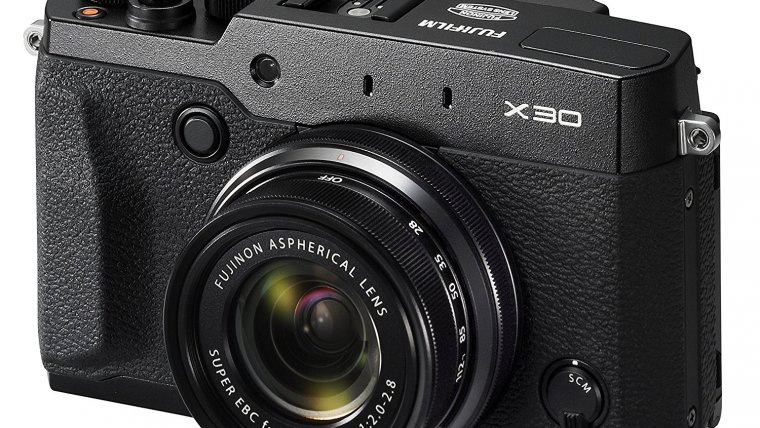
Fujifilm X30 Review: Finding Your Very Own Mirrorless Camera www.sleeklens.com
With the steep rise of mirrorless cameras the compact camera market never needed a little breath of fresh air as it needs it now. Sony did it with their RX lineup of cameras and now Fuji aims to bring some new blood with the X30. Where Sony's latest is aimed at the more advanced users with deeper pockets Fuji's plan is to do a similar thing for a lot less money.
While the X30 has a smaller sensor and doesn't sound as advanced in some areas it still looks like quite a bargain when you take a look at its specs sheet. It's always refreshing to see a compact camera with larger than average sensor, fast lens and quality hardware and the X30 ticks all of those boxes. We really like what Fuji has come up with in regards to this camera and we hope that our impressions will be positive enough and worthy of such an established manufacturer. Let's see if we are in for a surprise or the X30 will really be a worthy enough alternative for those who want a great advanced compact camera that doesn't cost an arm and a leg to buy.
It would be an understatement to call the specs list of the X30 an interesting one. As usual, we will begin our talk with the camera's sensor. Here you'll find a 2/3 inch 12 megapixel X-Trans CMOS II sensor. This means that the sensor size lies between the conventional compact camera and the Sony's familiar 1 inch sensors and we could call it a golden middle for a camera at this price point. So, you could expect the image quality that sits right in between.
Pros
Cons
The X30 comes equipped with a hybrid AF system that consists of 49 focus points. This is also another thing that sets it apart from some other compact cameras and in theory it should perform quite well. The body of the X30 is made out of magnesium alloy which is something we weren't expecting to see on a camera in this price range and we are happy that Fuji tries to bring the quality of their more premium offerings even to the lesser priced ones. Other than having a healthy amount of manual controls it also contains a 3 inch 920,000 dot TFT-LCD screen, an EVF with a high resolution of 2,360,0 00 dots and a popup flash with a maximum range of 7 meters.
There's also a micro-HDMI port and built in Wi-Fi with support for 802.11b/g/n standards. It can record 1080p videos at 60 fps with stereo sound and you can also record even higher quality audio with the included microphone jack or mounting one on the hot shoe. Unfortunately, there is no headphone jack, but it's hard to expect it to be featured on a compact camera anyway.
Lastly, performance wise, the X30 can shoot at a burst rate of 12 fps which is very useful to have on any camera, let alone a small camera like this one. All in all, the specs sheet sounds very promising for the Fujifilm X30 and now it's time to dig a little deeper to see how well things hold up in the real world.
As we've already mention, the first thing that impresses about X30's body right from the start is it's build quality. It's build out of magnesium alloy with faux leather accents added for better grip and a little more style and it really looks like a lot more expensive camera then it really is. The healthy amount of manual controls, an EVF and a screen that can also be tilted also help to improve the overall impression and make the X30 shine with a really positive vibe. The feeling doesn't change when you hold it in your hands as it feels really well to hold.
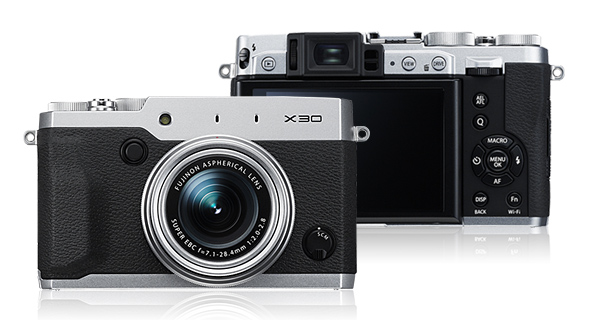
At 423 grams, it isn't the lightest compact camera around, but the added weight makes it feel more substantial in the hand and there's nothing wrong with that. The buttons and the dials themselves are also nicely laid out and each of them fits in its place. Let's take a closer look at which manual controls you get at your disposal. Straight from the front of the camera you will find the function button and a dial to switch between main focusing modes. The top of the camera holds the popup flash unit, a hot shoe, main mode dial, exposure compensation dial, direct record button and the shutter button. Finally, on the back, you'll find switch to raise the flash from the body, Playback, View and Drive buttons, control dial for adjusting the shutter speed, AF/AE lock and Q menu button, four navigation buttons that also double as a Timer, Macro, Flash control and AF menu buttons and a Menu/OK button inside that button array. Underneath them lie the Disp button that also works as a Back button when navigating through the menus and a customizable Fn button that defaults to being a button to access the Wi-Fi menu.
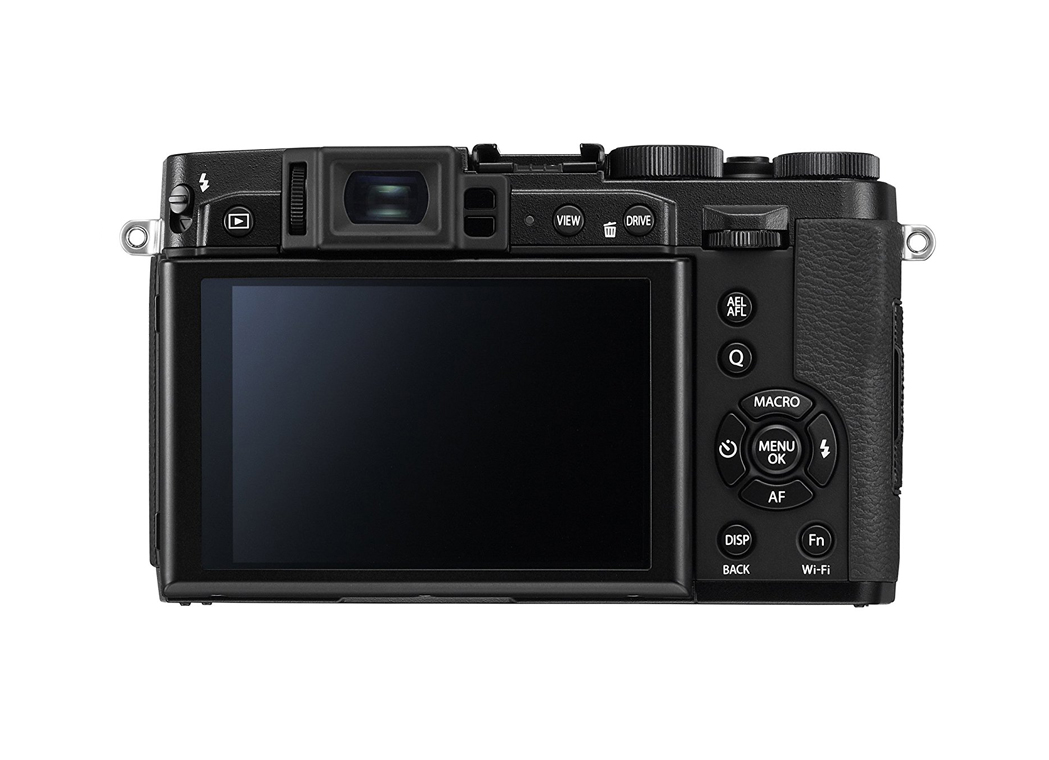
The top of the camera holds the popup flash unit, a hot shoe, main mode dial, exposure compensation dial, direct record button and the shutter button. Finally, on the back, you'll find switch to raise the flash from the body, Playback, View and Drive buttons, control dial for adjusting the shutter speed, AF/AE lock and Q menu button, four navigation buttons that also double as a Timer, Macro, Flash control and AF menu buttons and a Menu/OK button inside that button array. Underneath them lie the Disp button that also works as a Back button when navigating through the menus and a customizable Fn button that defaults to being a button to access the Wi-Fi menu.
We should also mention all the added functionality you gain with the two rings that can be found on the lens of the camera. The ring on the front is a traditional zoom ring while the one on the back is a control ring which is a new addition for the X series of cameras. You can program it to do different things like allowing you to change the aperture, shutter speed, ISO or white balance, focus manually or to switch between different film simulation or AF drive modes. We really appreciate when camera manufacturers give a camera more ways to control it so more users can customize it to their liking. Having more options is never a bad thing, especially those that are generally useful and well implemented like this lens control ring is. The screen on the back of the X30 is a tilting screen of good quality and at a decent resolution of 920,000 dots, but it's not one of the main selling points of this camera. That attention belongs to the integrated 2,360,000 dots electronic viewfinde r. The one on the X20 was an optical one and wasn't implemented that well and this time it's replaced with an excellent EVF. It's sharp and
Having more options is never a bad thing, especially those that are generally useful and well implemented like this lens control ring is. The screen on the back of the X30 is a tilting screen of good quality and at a decent resolution of 920,000 dots, but it's not one of the main selling points of this camera. That attention belongs to the integrated 2,360,000 dots electronic viewfinder. The one on the X20 was an optical one and wasn't implemented that well and this time it's replaced with an excellent EVF. It's sharp and colors real pop and come to life the moment you take a look through it. It also shows all the changes in your images in real time like white balance, exposure or film simulation effects, something that can't be said for the optical viewfinders. Its refresh rate is also quick and you won't notice any lag. It's great that we've come to that point in time when we can find such components of such high quality on cameras that don't come with premium prices attached to them.
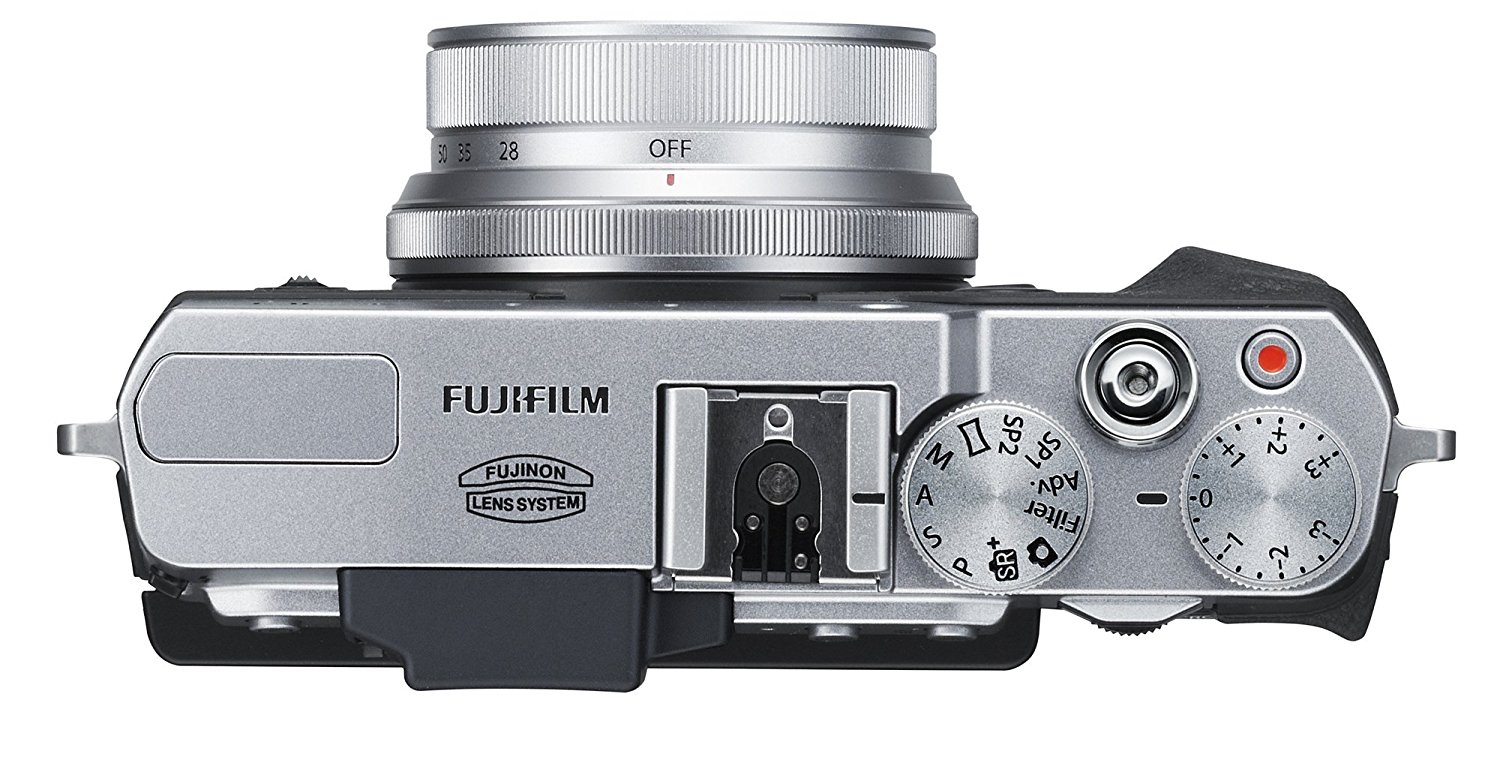
One area where the X30 shines control-wise is in its menu system which is one of the best we've found on any compact camera. It's really straightforward and easy to use no matter what previous experience you had with Fuji's cameras. Everything is in its logical places and each of the most important categories are marked with appropriate icons and different colors. The Q, or Q menu is also nicely implemented and you can have all of your most important functions pop out with just a press of the button. The navigation buttons are used to scroll between different options and the dial that's located near the thumb grip is used to change their values. It's a nicely thought out control scheme and works very well in real use. You can also
You can also customize the way that elements on the screen look like while you're in live view in addition to being able to use the standard viewing mode. Like many other today's cameras, the X30 also has built in Wi-Fi and a lot of different features that require that functionality. You will be using the Fujifilm Camera Remote App to do most of that functionality and you can install it either on your iOS or Android device. It offers you all the necessary features like being able to backup photos to your smart device or embed those photos with GPS information you have gathered on your smartphone or tablet. Like the name of the application implies, you can also remotely control the X30 and adjust a myriad of settings like shutter speed, ISO, aperture, white balance, exposure compensation and so on. You can also easily backup your photos on your PC if you wish. The X30 really covers almost all of the bases in regards to its body and the usability in general. Some people will mis s the option to have a touchscreen, but that's the only real flaw that we're able to single out in the sea of good things that could be said about this camera. Fuji
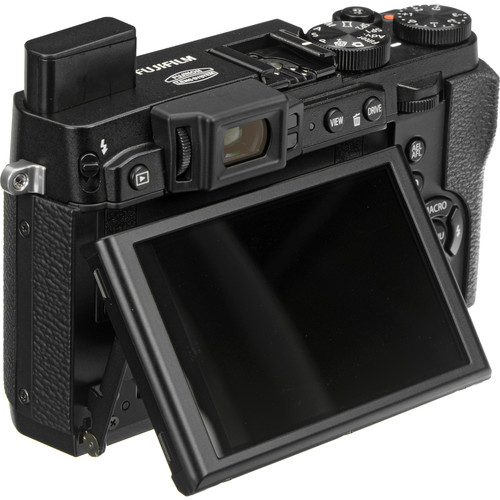
Like the name of the application implies, you can also remotely control the X30 and adjust a myriad of settings like shutter speed, ISO, aperture, white balance, exposure compensation and so on. You can also easily backup your photos on your PC if you wish. The X30 really covers almost all of the bases in regards to its body and the usability in general. Some people will miss the option to have a touchscreen, but that's the only real flaw that we're able to single out in the sea of good things that could be said about this camera. Fuji have really done a great job in this regard even when you ignore that the X30 isn't the most expensive camera around.
The Fuji X30 has a little more advanced autofocus system than ones found on most of the compact cameras. It's a hybrid AF system that consists of both contrast and phase detect focus points. The general idea with such a system is that it can predict what's happening in your image frame and decide which points to use depending on the situation, meaning it will lean towards using contrast detect points if your subject is a static one and phase detect points if it's moving. You can also manually decide which points to use with a myriad of different AF modes.
In reality it all works very well and the system never felt sluggish in any way and in almost all occasions we've ended up with photos that are in sharp focus. The performance drops a little in low light, but even than it's a pretty respectable showing. Another great thing about the X30 is that it comes with an impressive Macro mode that lets you focus as close as 1 cm at the widest angle. Focusing manually is also a pleasure with this camera because of well implemented focus peaking and the control ring on the camera's lens. The only thing that degrades the experience a little is the lack of touchscreen which would make focusing even easier and more intuitive. It's still not a problem to move your desired AF point by using the navigation buttons, but it would still be nice to be able to do it with Touch AF. Oh well, at this price point some sacrifices had to be made and the lack of touchscreen isn't the biggest one.

Photo courtesy of velodenz
The general performance of the Fuji X30 is great in every way as it performs every task with ease and without any hesitation. It's a performance worthy of even an upper-class camera. The maximum burst rate of 12 fps is also nothing to scoff at and is a really respectable number for a compact camera. It does take some time to save all those files and the buffer size isn't the largest, but it's still something useful to have to deal with moderately fast moving subjects.
In regards to battery life, which sits around 470 shots, Fuji have made some interesting design choices to make it better than most of the competition. The obvious one is a bigger than average battery cell, but the other one is the decision to make the lens only be able to zoom in or out manually, just like on a traditional interchangeable lens camera. This immediately saves some battery power and also makes the X30 feel like a more advanced camera than most compact ones because of the feel you have when manually changing the focal length. All of this leaves us with yet another area in which the X30 really shines over its competition, so far, so good.
While you wouldn't be surprised to see a compact camera at this price to offer much in terms of video capabilities you'd be pretty happy to know that the X30 doesn't disappoint in this regard. While it doesn't offer recording in 4K resolution it still does so at a respectable 1080p resolutions and at a high frame rate of 60 fps. There are also some basic slow motion modes available at frame rates raging from 80 to 250 fps, but they are of limited use since the resolution can drop from 640×480 to an even lower one. The X30 records pretty decent stereo sound, but you can always improve it by adding an external microphone. Another surprising thing is that the X30 offers full manual control in video and you can adjust everything from
The X30 records pretty decent stereo sound, but you can always improve it by adding an external microphone. Another surprising thing is that the X30 offers full manual control in video and you can adjust everything from aperture, shutter speed, ISO and so on. You can also manually focus relatively easily with focus peaking. The quality of recorded videos is good when there's enough light in your scene, but it drops to being average at best in low light scenarios. There is continuous autofocus available, but it isn't the best implementation we've ever seen and you should only rely on it in some occasions where you don't need critical focus and use manual focus rest of the time.
There is continuous autofocus available, but it isn't the best implementation we've ever seen and you should only rely on it in some occasions where you don't need critical focus and use manual focus rest of the time.
This brings us to the topic of image quality, something that we're sure most of you are interested in. Just like we suspected right from the start it indeed sits between the regular compact camera and the RX100 V. You can get some really nice looking images at lower ISO levels no matter if you're shooting in JPEG or RAW mode. There is enough detail in those photos to satisfy almost every user and we also have to mention the impressive dynamic range.

Photo courtesy of Littleland
In lower light, the quality is average and ok for such a smallish sensor. If you want to get the most out of those photos, stick to RAW mode because the noise reduction in JPEGs can be a tad too strong and smear away some fine detail. If you decide to shoot in JPEG you will be able to take advantage of numerous Film simulation modes and all of them really look quite stunning. So, while not being perfect, the image quality on the X30 is exactly what we expected and didn't disappoint us in any way.
We can safely conclude that Fuji made an excellent camera to make a push on the market of more affordable cameras and the X30 in some ways feels like it's a part of the more expensive lineup and competing with some more advanced offerings. While Fuji did cut some corners to achieve its price point like implementing a smaller sensor, deciding not to include a touchscreen or 4K video recording our impressions are still very positive and every time we used the X30 we felt like it's one well-rounded camera. Fuji really nailed some things like the body quality, the viewfinder, battery life, autofocus and general performance. Image and video quality are also good, but at this price
Fuji really nailed some things like the body quality, the viewfinder, battery life, autofocus and general performance. Image and video quality are also good, but at this price point they aren't one of this camera's major selling points. The lens on the X30 is also quite versatile and bears a very bright maximum aperture together with image stabilization and that is also another positive aspect of this camera. All in all, if you are looking for a compact camera that won't empty your wallet with one swoop breeze, but you still want something capable and able to deliver the good stuff, you should definitely consider the Fujifilm X30.
Rating: 0 based on 0 Ratings
The following two tabs change content below.An amateur photographer, songwriter, musician, computer and technology geek and an occasional comedian, I'm a little bit of everything. I always aim to pursue things I'm passonate about and try to look on the positive side of things whenever I can. My mission is to wrap my articles in that aura of positive energy and keep a healthy balance between being serious about my work and spicing things up with a little fun now and than. After all, life's a game and there's always a different way to play it.
Most popular posts in Apr
Source: Fujifilm X30 Review: Finding Your Very Own Mirrorless Camera
No comments:
Post a Comment